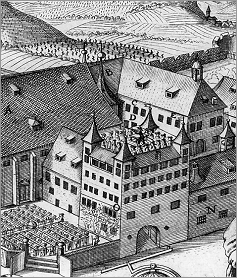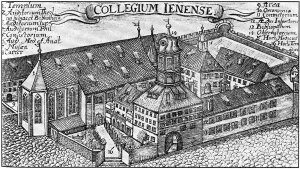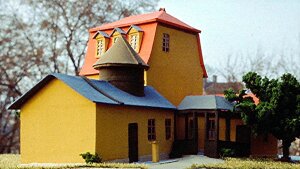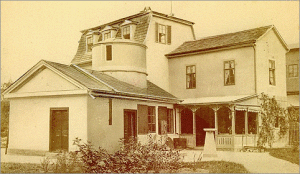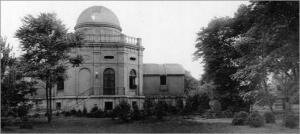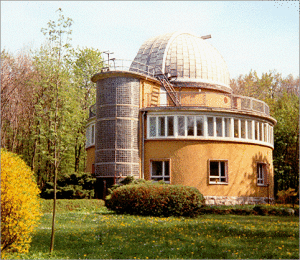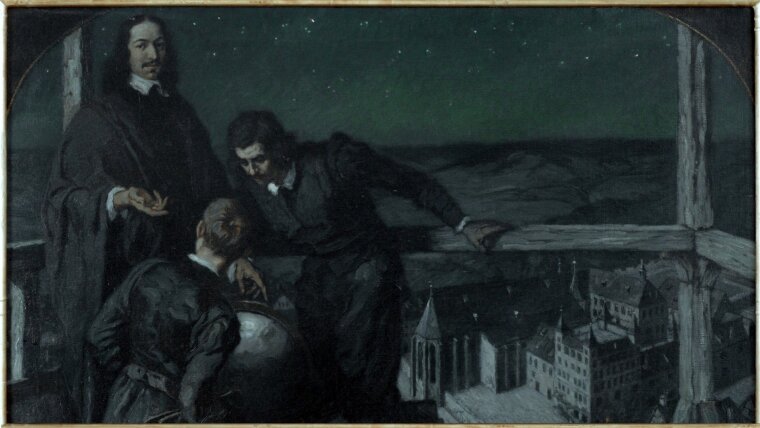
Weigels Observatorium 1657 im Collegium Ienense
Image: Public DomainAstronomy has been continuously cultivated at the University of Jena over the past 450 years like no other place in Central Europe. Even the founding professors Johann Strigel and Victorin Stigel were astronomically educated.
Georg Limnäus, professor from 1588 to 1611, was widely known. The young Johannes Kepler sent him - alongside Galileo Galilei - a copy of the »Mysterium cosmographicum«. Limnäus then wrote to him to say that he had set up a small observatory in Jena; unfortunately, it can no longer be located today. Heinrich Hoffmann and his students gave reasons for the astronomical internship in Jena around 1620.
The university, and with it Astronomy, experienced a particular upswing with the appointment of Erhard Weigel in 1652. He was highly regarded as a university lecturer and the number of students at the university doubled to around 1500 within a few years. Weigel also became known for his globes and above all for his commitment to calendar reform in the reformed countries of Europe.
Modell der Goetheschen Sternwarte im Schillergäßchen, 1813
Image: R.E. SchielickeThe astronomical interest of Duke Carl August of Saxe-Weimar-Eisenach was rekindled after 1810 by the publisher Bertuch, the mathematics professor Werneburg and the State Councillor von Müffling from Weimar. Carl August decided to facility|institution|(structural) unit an observatory in Jena's Schillergäßchen and commissioned Goethe - initially against his resistance: Goethe knew the costs of the Gotha observatory - to supervise it. Finally, the first director of the Jena observatory, Karl Dietrich von Münchow, was able to observe the first fixed star transits on 3 September 1813, the Duke's birthday.
Goethe instructed: »Itis made the duty of the astronomer to constantly keep exact time, to diligently observe all star occultations and other celestial occurrences that can serve to determine longitude, and to enter both these observations and all others made by Astronomy for the advancement of science and new discoveries in manuals, which, together with the manuals on the movement of the clock, are carefully kept in volumes as a property of the observatory«.
A number of instruments from those years are now part of the institute's collection, and the observatory's historical library was given reasons for its existence. Von Münchow accepted an offer of professorship in Bonn in 1819, his successor Friedrich Posselt died in 1823, after which Ludwig Schrön was director of the Jena Observatory until his death in 1875.
Die Sternwarte nach der Rekonstruktion durch Abbe, 1878 bis 1889
Image: Sammlung KnopfIn 1877, Ernst Abbe was asked by the university curator for an assessment report|review on the continued existence of astronomy in Jena: he described astronomy as a »schoolof the exact art of observation« and took over the directorship until 1900, thus saving Jena's astronomy from extinction, just as he ensured the preservation of the university as a whole in those years by establishing the Carl Zeiss Foundation. He and his family moved into the restored observatory, where he lived until 1886.
Abbes Sternwartenneubau, 1889
Image: Sammlung KnopfIn 1889, Ernst Abbe had a new observatory built. Shortcomings in the procured instruments prompted him to set up an astronomy department at the Zeiss factory in Jena in 1897 - another special feature of Jena's astronomical history: the industrial production of astronomical instruments.
Die Sternwarte im Schillergäßchen, 1903
Image: Sammlung KnopfWith the completion of his new observatory, Ernst Abbe employed Otto Knopf as his assistant, who soon qualified as a professor and succeeded him in 1900. As a »classical astronomer«, Knopf carried out geographical positioning and orbit determination of small planets and comets. He was in close, far-reaching contact with his specialist colleagues. He was the first to consider an observation station outside the Saale Valley to be urgently needed. Before his retirement in 1927, he deliberately wanted to give his successor a free hand in the astrophysical orientation of his institute.
Heinrich Vogt from Heidelberg, who returned there in 1933 as agreed, was the first to establish astrophysics in Jena.
Das Observatorium der Friedrich-Schiller-Universität bei Großschwabhausen, 1963
Image: R.E. SchielickeHermann Lambrecht took over the management of the observatory in 1945. He had received his doctorate from Siedentopf in 1934 and habilitated in Breslau. With the study of interstellar matter that he introduced, Jena began decades of sustainable research - continued by Lambrecht's successors Helmut Zimmermann and Karl-Heinz Schmidt - which, after the collapse of the GDR under the directorship of Werner Pfau, also led to the founding of a »Dust in Star Formation Regions« research group of the Max Planck Society. Today, extra-solar planets are observed, neutron stars are studied and dust disks around distant stars are investigated - and recently our own sun has also been brought back into focus. For their observations, the astronomers at the observatory and their students use the most suitable observatories in the world as well as their own observatory in Großschwabhausen near Jena.
Text and images by Dr Reinhard E. Schielicke
(slightly supplemented by Ralph Neuhäuser)
- A short walk through the history of astronomy in Jena de
- Directors and institute names of the Jena Observatory de
- Timeline of the building history de
- R.E. Schielicke: History of Astronomy at the University of JenaExternal linkde
- R.E. Schielicke: Astronomische Berichte aus Jena aus den Publikationen der Astronomischen GesellschaftExternal linkde
